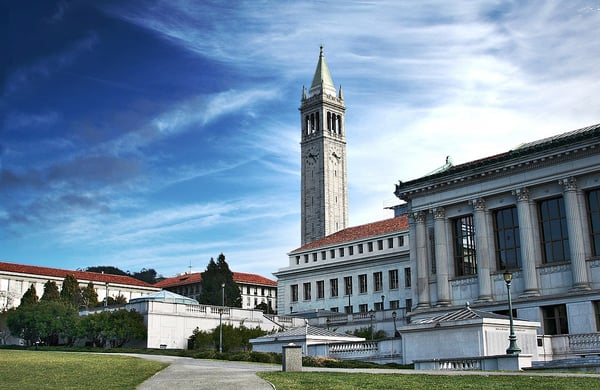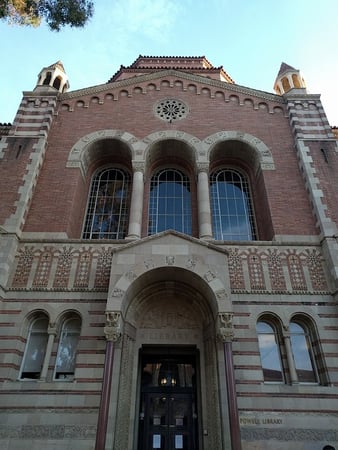
Choosing a college in California can be tough, especially since there are so many great options available. One of the best school systems to choose from is the University of California.
In this article, we’ll provide a complete, ranked list of the best UC schools, give you information about each. We’ll list the campuses, give you important stats like how much each costs…and so much more!
That way, you can pick the UC school that’s best for you. Let’s get started!
Featured Image: brainchildvn/Wikimedia Commons
What Is UC?
The University of California (UC) is a public university system in—you guessed it!—California. UC has a student body of 294,309 students, around 241,000 faculty, staff, and other researchers, and over 2 million living alumni around the world. Compared to the 10 faculty members and 40 students they started with in 1869, we’d say that’s pretty impressive growth!
The UC system is highly regarded and almost all of its campuses are considered “Public Ivies.” That’s probably why UC has produced 70 Nobel Prize winners, 93 MacArthur “Genius” grant winners, and 40 Pulitzer Prize winners, just to name a few successes.
How Many Schools Are Part of the University of California?
There are 10 schools in the University of California system, 9 of which offer both undergraduate and graduate degrees. UC San Francisco is the only UC school without an undergraduate program. Here’s the list of all of the UC schools, listed alphabetically:

The UC Schools are located throughout California. (No guarantee you’ll see bears on campus, though.)
UC Rankings: Which School Is Best?
With 10 unique schools to choose from in the UC system, it’s a challenge to decide which are the best UC schools to apply to. We’ve created a University of California rankings list to help you narrow down your UC school list (remember that we’re excluding UC San Francisco, since it’s exclusively for graduate and professional school).
Keep in mind that college rankings are usually subjective and can be flawed, so it’s important to spend time researching and visiting the colleges you’re interested in, rather than just accepting college rankings as facts.
The table below lists the schools alphabetically and shows their rankings from four well-known and vetted college ranking sources: US News & World Report, Forbes, Niche, and Times Higher Education.
|
US News Top National Universities |
Forbes America’s Top Colleges |
Niche Top Public Universities in America |
Times Higher Education Top US Colleges |
|
|
UC Berkeley |
#20 |
#2 |
#9 |
#36 |
|
UC Davis |
#38 |
#23 |
#24 |
#40 |
|
UC Irvine |
#34 |
#30 |
#16 |
#87 |
|
UC Los Angeles |
#20 |
#6 |
#5 |
#27 |
|
UC Merced |
#97 |
#309 |
#235 |
Unranked |
|
UC Riverside |
#89 |
#84 |
#106 |
#184 |
|
UC San Diego |
#34 |
#17 |
#20 |
#43 |
|
UC Santa Barbara |
#32 |
#39 |
#25 |
#76 |
|
UC Santa Cruz |
#83 |
#87 |
#164 |
#264 |
For the UC schools ranked on the list below, we averaged the rankings from US News, Forbes, Niche, and Times Higher Education, and we also considered real student reviews from each school.
Without further ado, here are our University of California rankings.

Spoiler alert: UCLA takes the top spot on our UC school rankings list.
#1: UC Los Angeles
- Acceptance rate: 11%
- In-State tuition: $14,478
- Out-of-State tuition: $47,052
Starting the list out strong, UC Los Angeles takes the #1 spot in the University of California rankings. Founded in 1919, UC Los Angeles (UCLA) was the fourth University of California school added to the system. The school is located in Westwood, California, a neighborhood in West Los Angeles, and it’s a little over 8 miles from Santa Monica Beach.
UCLA has over 32,000 undergraduate students in over 250 degree programs. Economics, Sociology, and Biology are the most popular undergraduate majors.
Notable academic programs (ranked by US News) include:
US News ties UCLA with UC Berkeley at #1 on the list of top public schools, and Forbes ranks it as the #6 university in America.
Additionally, real student reviews suggest that UCLA’s safety, dorms, and campus are excellent. In fact, UCLA received exceptionally high marks across the board, with its lowest—safety—still earning a B on Niche’s grading scale.
Student reviews compliment the vibrant and inclusive campus environment, the campus location, and the challenging courses, but they mention concerns about lack of accessibility and help for non-traditional students, as well as difficulty getting into preferred classes because of the large number of students on campus.
#2: UC Berkeley
- Acceptance rate: 15%
- In-State tuition: $15,444
- Out-of-State tuition: $48,018
#2 on our list of UC rankings is UC Berkeley. Established in 1868, UC Berkeley is the oldest college in the UC system and has over 32,000 undergraduate students that attend its 1,232 acre campus in Berkeley, California—located north of Oakland and 15 miles across the bay from San Francisco.
UC Berkeley offers over 350 undergraduate degree programs, and the most popular majors among students are Computer Science, Economics, and Cellular Biology.
Notable academic programs (ranked by US News and Niche) include:
Forbes currently has the UC Berkeley ranking at #2 on the list of top colleges in America, and US News ranks it as the #1 public university in the nation.
Real students at the school say that academics, diversity, and student life are especially great at UC Berkeley. They mention that the school offers a unique academic culture, and that social justice initiatives allow students to impact their community and the world.
Safety, dorms, and the campus, overall receive the lowest marks, with students voicing concerns about increased numbers of robberies and assaults, overcrowding on campus and in dorms, and outdated facilities around campus.
#3: UC San Diego
- Acceptance rate: 34%
- In-State tuition: $17,361
- Out-of-State tuition: $48,387
Next up on the list is the UC San Diego college ranking, coming in at #3 on our list. UCSD’s campus is situated in La Jolla, California in northern San Diego, a very affluent community with a beautiful coast along the Pacific Ocean. Over 33,000 undergraduate students attend the university.
The most popular majors among undergraduates are Biology, Cognitive Science, and International Studies. Other notable academic programs (UC San Diego college rankings from US News and Niche) include:
UCSD has an A+ grade overall on Niche, with academics, diversity, professors, and value scoring the highest and dorms scoring the lowest.
Many students praise the beautiful campus and large number of clubs and other recreational activities available. Students also mention how knowledgeable their professors are, which isn’t super surprising since 16 Nobel Laureates have taught at UCSD.
However, others complain about the school’s underwhelming social scene, the large campus, and few affordable student housing options.
#4: UC Davis
- Acceptance rate: 49%
- In-State tuition: $13,104
- Out-of-State tuition: $44,130
The fourth spot on our list is filled by the UC Davis ranking. The third college added to the UC system, UC Davis has served students since 1908, and it currently has over 31,000 undergraduate students. This is the largest campus in the UC system by area, occupying over 5,300 acres in Davis, California, about 16 miles west of Sacramento.
The most popular undergraduate majors at UC Davis are Research and Experimental Psychology, Economics, and Management Sciences and Information Systems. But UC Davis has plenty of options for everyone with 100+ academic programs to choose from.
Notable academic programs (ranked by US News and Niche) include:
Forbes ranks UC Davis as #23 on the list of best American universities, and Niche ranks it as #24 in top public universities. UC Davis has a solid A Niche grade as well. Its lowest categories are safety (B), location (B+), and dorms (B+), and its highest include diversity (A+), and professors (A+).
Many student reviews mention the incredible diversity on campus, with one student saying that “the great change in diversity allows [them] to express and face new challenges that [they] would not back home.” Other positive reviews talk about the warm and welcoming college-town atmosphere, the abundant nature in the areas surrounding the campus, and the dining room food.
One of the common complaints about the school is high costs. Many students feel that tuition, housing, and food are overpriced. Students also say that getting into preferred classes can be a challenge, since there are so many other undergraduates competing for spots.

UC Davis Memorial Union (Borawik/Wikimedia Commons)
#5: UC Irvine
- Acceptance rate: 29%
- In-State tuition: $13,752
- Out-of-State tuition: $46,326
The UC Irvine ranking on our list comes in at #5. UCI was established in 1965, making it one of the newest schools in the UC system. It’s located in Irvine, California, and the city has been voted the safest city of its size in the US for 17 years straight. UCI’s 29,000+ undergraduate students have plenty of Pacific coast to enjoy in their downtime, since campus is seven miles from Newport Beach and 11 miles from Huntington Beach.
There are 155+ academic programs for undergraduates to major and minor in at the University of California Irvine. The most common majors at UCI are Biology, Computer Science, and Managerial Economics.
Notable academic programs (ranked by US News and Niche) include:
UC Irvine is #8 in top public universities and #34 in public universities according to US News, and Forbes ranks UCI as #30 on the list of top universities in America.
Students at UCI rank academics and diversity very high, and even though safety received a Niche grade of B+, many students say that they feel safe on campus and in the surrounding city. The beautiful campus, diverse student clubs, and relaxing campus atmosphere are also frequently mentioned in student reviews.
That same relaxing atmosphere that many students like, though, makes others feel like UCI is a little boring when it comes to the social scene. Other student complaints mention large class sizes—UCI has an average student/faculty ratio of 18:1—that make it difficult to form connections with professors and other students.
#6: UC Santa Barbara
- Acceptance rate: 29%
- In-State tuition: $13,104
- Out-of-State tuition: $44,130
#6 on the list of UC rankings is UC Santa Barbara. UCSB is the second oldest college in the UC system (founded in 1891), and it has over 23,000 undergraduates enrolled on its campus in Isla Vista, California, which is about 11 miles from Santa Barbara and 100 miles from Los Angeles.
UC Santa Barbara offers over 200 academic programs, and the most popular majors are Sociology, Economics, and Communications.
Notable academic programs (ranked by US News and Niche) include:
US News ranks UC Santa Barbara at #7 on the list of top public universities and #34 on the list of best national universities.
Unsurprisingly, what students seem to love most about UCSB is the scenery. The school has its own beach with many others nearby along the Pacific coast, and students like the cool campus atmosphere.
According to students, UCSB boasts an A+ party scene, which is both a positive and negative for students. Niche reviews say that they were able to make lots of friends and join many groups because of the many social events, which explains how it got its A+ grades for student life and party scene—as well as its ranking as #1 on the list of Niche’s top party schools in America.
However, other students complain that they aren’t able to focus on schoolwork because of all the parties, and there’s a lot of trash around campus and the surrounding area.

UC Santa Barbara Library (UCSB Library/Wikimedia Commons)
#7: UC Riverside
- Acceptance rate: 66%
- In-State tuition: $13,104
- Out-of-State tuition: $44,130
UC Riverside takes the #7 slot on our UC rankings lists. The school was added to the UC system in 1954, and it currently has over 22,000 undergraduate students on its campus in Riverside, California, located about 60 miles east of Los Angeles.
Of the school’s 75+ academic programs, Business, Research and Experimental Psychology, and Biology are the most common majors among undergraduates. Other notable academic programs (ranked by US News and Niche) include:
UC Riverside is ranked #84 on US News’ list of top national universities, and Forbes ranks it as #84 on the list of top American universities.
The school also has an overall Niche grade of B+, with its highest grades in student life (A-), campus food (A-), and party scene (A-). Its lowest grades are for location (C+) and safety (C+).
Real UC Riverside students like the campus, overall, and many also like the diverse clubs and service opportunities. The main complaints students have are about safety, with an increased level of homelessness and crime in the surrounding area.
#8: UC Santa Cruz
- Acceptance rate: 59%
- In-State tuition: $15,288
- Out-of-State tuition: $47,862
UC Santa Cruz takes the #8 position on our list. Established in 1965, UCSC has 17,000+ undergraduates on its campus in Santa Cruz, California—a town about 35 miles southwest of San Jose and 75 miles south of San Francisco. UCSC is located between the Monteray Bay and redwood forests, and it actually has its own natural reserve that spans sections of the campus.
UCSC has over 100 academic programs for undergraduates to choose from. Computer Science, Psychology, and Cellular Biology are among the most common majors. Other notable academic programs (ranked by US News and Niche) include:
UC Santa Cruz is ranked as #2 on Niche’s list of the most liberal colleges in America, and Forbes ranks it as #87 on their list of the top universities. However, UCSC gets a few low marks from students on Niche, especially in dorms (C-), athletics (C-), and safety (C+). Scoring highest is diversity (A), professors (A-), and academics (B+).
When asked to give one word or phrase to describe the school, students at UC Santa Cruz said things like “beautiful campus,” “collaborative environment,” and “friendly.” The forest setting seems to be the main things students like, though the beach is just a bus ride away.
Many students complain about how hard it can be to find on-campus housing, as well as the “hard-core liberal scene” and emphasis on social justice. However, whereas some students complain about these aspects of the school, others seem to enjoy them the most.
#9: UC Merced
- Acceptance rate: 87%
- In-State tuition: $14,840
- Out-of-State tuition: $47,414
The ninth spot on our list goes to UC Merced, the newest school in the UC system (2005). Its 8,000+ undergraduate enrollment also makes it the smallest school on our list as far as student population goes. The school also boasts that its central location in Merced is “in the middle of everything.”
Undergraduates can choose from just under 50 academic programs. Biology, Psychology, and Business are among the most popular majors chosen. Other notable academic programs (ranked by US News and Niche) include:
UC Merced is ranked at #97 on US News’ list of top national universities, but that ranking is drastically different from Forbes’ #309. The highest grades given to UC Merced on Niche are for professors (A), dorms (A-), and safety (A-), and its lowest are for athletics (C+), location (C-), and campus food (C-).
Students at UC Merced describe typical students at the school as “hardworking,” “friendly,” “easy going,” and “intelligent.” They also think the location is great for students who want to see and experience different parts of California.
What students like the most about UC Merced is the same thing others dislike: the small campus community and rural setting. This smaller setting may also be responsible for UC Merced having the highest Niche safety grade across all the UC schools ranked.
Students that dislike the small student population and surrounding areas noted that they had to adjust to how early businesses in the area close, as well as how long it takes to travel to larger cities and attractions across the state.

UC Merced at night (Qymekkam/Wikimedia Commons)
The Best UC Schools Ranked: How To Choose Which UC College Is Best for You
After reading through the UC rankings and learning more about each college, your list of UC schools may still be pretty long. Here are a few things to consider that will help you narrow down your UC search.
First, you’ll need to ask yourself a few questions to figure out exactly what you’re looking for in a college. To begin, grab a pencil and write down your thoughts on the following questions:
- Who are you? What kinds of things do you value? How do you see those values transferring to a college campus, community, and experience?
- What do you want to get out of your college education? What academic areas are you interested in studying? What kinds of academic endeavors do you value? Challenging classes? Innovative research? Hands-on internships?
- What do you want to get out of your college experience? Do you want it to be fun-filled with lots of activities, sports, or clubs? Do you want it to be quiet, relaxing, and inspiring?
- Where are you the happiest? Is a bustling campus and surrounding city your thing? Or do you prefer a calmer, more natural setting? Maybe something in between?
Once you have the answers to those questions, follow these steps.
Step #1: Compare Your Values to Each School
The UC schools share an overall system, and they share a common mission: to “serve society as a center of higher learning, providing long-term societal benefits through transmitting advanced knowledge, discovering new knowledge, and functioning as an active working repository of organized knowledge.”
However, each UC school is unique and has its own missions and values. To start learning about each of the UC schools’ missions and values, just Google “UC [college name] Mission Statement.”
For example, UC Santa Barbara’s Mission Statement says that they value “academic inquiry and interpersonal connection to inspire scholarly ambition, creativity, and discoveries with wide-ranging impact.” Students and faculty are “inquisitive and curious, community-driven and globally-focused.”
In contrast, UC Santa Cruz’s Mission Statement says they “[value] and [support] every person in an atmosphere of civility, honesty, cooperation, professionalism and fairness.” Students and faculty are “diverse, open, purposeful, caring, just, disciplined, and celebrative.”
Learning about each UC schools’ unique missions and values can help you figure out which one best aligns with your own, and you can be proud to attend a college that supports you in your academic and personal missions.
Step #2: Look At Your Academic Interests
If you already know what you want to study in school, you’re well on your way to choosing which UC school is best suited for you.
The UC schools offer tons of academic programs for undergraduates. Keep in mind that more majors available at a school doesn’t always mean better. If you already know what you want to study, it doesn’t really matter how many other degree programs the college offers.
If you know you want to study computer science, for example, you’d start by searching through each college’s degree offerings to make sure they offer computer science as a major.
From there, you can learn about the computer science programs at each school. For instance, some computer science programs are ranked higher than others (UC Berkeley’s program is ranked #1 in the nation, whereas UC Irvine’s program is unranked), and some have stricter requirements for admission and getting your degree.
If you haven’t decided yet, that’s okay! Lots of students decide their majors after enrolling in college. If you’re wanting to shop around, think about choosing a school with a larger number of academic programs. You’ll have a wider variety of classes you can take and more academic subjects you can learn about, so you’ll have a larger web of possibility when you do decide to pick a major.

Choosing a UC school doesn’t have to feel like going through a maze. We’ll help you pick the university that’s best for you.
Step #3: Explore Activities, Sports, Clubs, and More
All of the UC schools are very unique, and that includes all the different extracurriculars offered and overall social scene on and around each campus. One of the most important steps in choosing the best UC school for you is determining if you’d like to get involved on campus and which schools offer the best matches for those interests.
Searching for “UC [School Name] clubs and communities” can help you learn more about each school’s diverse offerings. Not every school offers the same programs, so this can be a great way to narrow down your list!
Checking out rankings for each type of club/community can also help you determine if a college works for you. For example, Niche ranks UC Santa Barbara at #16 on the list of top colleges for Greek life, and UCLA is ranked at #9 on the list of best colleges for student athletes.
Step #4: Decide on Your Happy Place
Let’s face it: it’s hard to go wrong with any of the UC colleges. They’re all well respected and have top-notch academic programs.
However, California is a huge state! It has a total area of over 163,000 square miles and 39 million residents, so of course, each UC school and its surrounding area has a different atmosphere. Learning about each campus, the towns they’re in, and student life is crucial for deciding which school and town you’ll thrive in.
Whether it’s the beaches surrounding UC Santa Barbara, the redwood forest of UC Riverdale, or UCLA’s bustling city, you’ll need to consider how that environment will shape your college experiences. Not every school and culture will work for you!
Step #5: Research Admission Requirements
The last step in figuring out the UC school for you is making sure you meet the admissions requirements.
Get started by checking out average GPAs of admitted students. To do this, use each school’s common data set (just Google ‘UC [college name] Common Data Set’ and look for the section on admitted student demographics and GPAs.
All the UC schools have adopted a test-blind policy, so your SAT and ACT scores won’t be considered on your actual application, but they can help you see how your own academic achievements stack up against students who were admitted.
Another important step is determining what each school looks for in incoming students. There are a few things you can Google to learn more about your chosen schools. Googling terms like “UC [School Name] eligibility and selection,” “UC [School Name] admission requirements,” and “what does UC [School Name] look for in applicants” will help you find exactly what each school wants in an ideal applicant.
That way you can make sure you meet requirements and stand out.

Recap: The Best UC Schools Ranked and How To Decide Between Them
In this article, we’ve ranked the University of California colleges (excluding UC San Francisco, which only offers graduate and professional degrees) in this order:
- UC Los Angeles
- UC Berkeley
- UC San Diego
- UC Davis
- UC Irvine
- UC Santa Barbara
- UC Riverside
- UC Santa Cruz
- UC Merced
We’ve also broken down each school and explored their acceptance rates, tuition costs, popular and well-ranked academic programs, settings, campus atmospheres, and student insights and reviews.
Now you’re ready to start exploring UC schools and to decide which one(s) to apply to. Before you commit, though, you should:
- Compare your values to each UC schools’
- Align your academic interests with schools that offer relevant degree programs
- Explore activities, sports, clubs, and more across the UC schools
- Decide on your happy place
- Research admission requirements and admitted students’ achievements
No matter which you choose, we wish you the best of luck with your University of California adventure!
What’s Next?
If you want to learn more about each UC school before you commit to one, be sure to check out this in-depth write-up by our admissions experts.
The UC application can be pretty intimidating! We’ll walk you through how to apply to UC schools, step by step.
The University of California isn’t the only major college system in the state! Cal State schools also offer students excellent educations. We’ll teach you everything you need to know about Cal State schools—including how they compare to UC universities.

Want to build the best possible college application?
We can help. PrepScholar Admissions is the world’s best admissions consulting service. We combine world-class admissions counselors with our data-driven, proprietary admissions strategies. We’ve overseen thousands of students get into their top choice schools, from state colleges to the Ivy League.
We know what kinds of students colleges want to admit. We want to get you admitted to your dream schools.
Learn more about PrepScholar Admissions to maximize your chance of getting in.

Source: blog.prepscholar.com